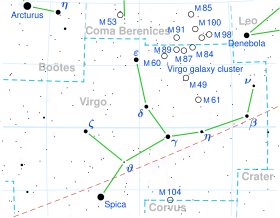
Back Syrma AST Iota de la Verge Catalan Iota Virginis German Σύρνα Greek Syrma Spanish یوتا دوشیزه Persian Iota Virginis French Iota Virginis Italian おとめ座イオタ星 Japanese Syrma Dutch
Iota Virginis (ι Virginis, abbreviated Iota Vir, ι Vir) is a binary star in the constellation of Virgo. Its apparent magnitude is 4.08.[2] Based on its parallax, it is assumed to be relatively nearby, at 71.8 light-years (22.0 parsecs).[1]
Its two components are designated Iota Virginis A (officially named Syrma /ˈsɜːrmə/,[7] the traditional name for the system)[8] and B.
- ^ a b c d e f Vallenari, A.; et al. (Gaia collaboration) (2023). "Gaia Data Release 3. Summary of the content and survey properties". Astronomy and Astrophysics. 674: A1. arXiv:2208.00211. Bibcode:2023A&A...674A...1G. doi:10.1051/0004-6361/202243940. S2CID 244398875. Gaia DR3 record for this source at VizieR.
- ^ a b Gray, R. O.; Napier, M. G.; Winkler, L. I. (2001). "The Physical Basis of Luminosity Classification in the Late A-, F-, and Early G-Type Stars. I. Precise Spectral Types for 372 Stars". The Astronomical Journal. 121 (4): 2148. Bibcode:2001AJ....121.2148G. doi:10.1086/319956.
- ^ a b c d e Gontcharov, G.A.; Kiyaeva, O.V. (2010). "Photocentric orbits from a direct combination of ground-based astrometry with Hipparcos II. Preliminary orbits for six astrometric binaries". New Astronomy. 15 (3): 324–331. arXiv:1606.08182. Bibcode:2010NewA...15..324G. doi:10.1016/j.newast.2009.09.006. S2CID 119252073.
- ^ a b Mermilliod, J.-C. (1986). "Compilation of Eggen's UBV data, transformed to UBV (unpublished)". Catalogue of Eggen's UBV Data. Bibcode:1986EgUBV........0M.
- ^ a b Aguilera-Gómez, Claudia; Ramírez, Iván; Chanamé, Julio (2018-06-01). "Lithium abundance patterns of late-F stars: an in-depth analysis of the lithium desert". Astronomy and Astrophysics. 614: A55. arXiv:1803.05922. Bibcode:2018A&A...614A..55A. doi:10.1051/0004-6361/201732209. ISSN 0004-6361. Iota Virginis' databasee entry at VizieR.
- ^ a b c d Baines, Ellyn K.; Clark, James H., III; Schmitt, Henrique R.; Stone, Jordan M.; von Braun, Kaspar (2023-12-01). "33 New Stellar Angular Diameters from the NPOI, and Nearly 180 NPOI Diameters as an Ensemble". The Astronomical Journal. 166 (6): 268. Bibcode:2023AJ....166..268B. doi:10.3847/1538-3881/ad08be. ISSN 0004-6256.
{{cite journal}}: CS1 maint: multiple names: authors list (link) - ^ "syrma". Oxford English Dictionary (Online ed.). Oxford University Press. (Subscription or participating institution membership required.)
- ^ "Naming Stars". IAU.org. Retrieved 16 December 2017.
© MMXXIII Rich X Search. We shall prevail. All rights reserved. Rich X Search
